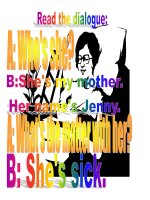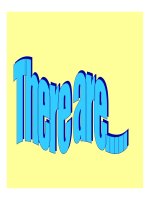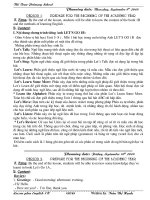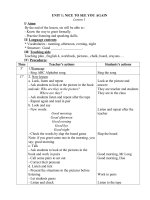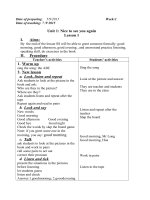giao an tieng anh lop 4 2016 2017 Thuy Van
Bạn đang xem bản rút gọn của tài liệu. Xem và tải ngay bản đầy đủ của tài liệu tại đây (172.04 KB, 30 trang )
<span class='text_page_counter'>(1)</span>Week 1: Monday, August 29 th , 2016 Starter: Welcome back ! Lesson One – Period 1 I/ Aims: - Identifying different places in a home. II/ Language contents: 1.Structure: Where’s …?This is… These are 2.Vocabulary: Welcome back, learning, end (v) Hide (v) / hiding, come out (v) III/ Teaching Aids: CD tracks 1-2, Starter story Poster IV/ Steps of teaching: 1.Warm up and reviews: - As children come into class, smile and say Hello. Encourage children to say Hello back to you. Say It’s a new year. Welcome back! 2. Presentation: Listen and sing: - Tell children that they are going to begin the lesson with a song. Ask children to open their Class Books and look at the three children at the top of the page. Point to each one in turn for children to tell you their names. Explain that they will see these characters the whole way through the course. - Explain that they’re going to listen to a 'Welcome back' song and then sing it. Play the recording once for children to listen and follow the song in their books. Focus attention on the words. Read each line for children to repeat after you. Play the recording again for children to sing along..
<span class='text_page_counter'>(2)</span> 3. Practice: Sing and do: -Ask children to think of some actions for the song. Play the song again for children to sing and do their actions. Repeat if you wish.. ---------------------------------------------------------------------------------------------------Lesson One – Period 2 I/ Aims: - Identifying different places in a home. II/ Language contents: 1.Structure: Where’s …?This is… These are 2.Vocabulary: Welcome back, learning, end (v) Hide (v) / hiding, come out (v) III/ Teaching Aids: CD tracks 1-2, Starter story Poster IV/ Steps of teaching: 1.Warm up and reviews: - Begin the class with some common greetings. Children then practice greeting each other in pairs or small groups. 2. Presentation: Listen and read - Use the Starter Story Poster to present the story. Point to the characters for children to say the names. Ask What’s happening in the story?/ Where’s Billy?/ Is he behind the door?... 3. Practice: - Look and write: 2. dining room 3. He’s in the bedroom. 4. She’s in the kitchen. 5. He’s in the bathroom..
<span class='text_page_counter'>(3)</span> 4. Production: - Describe a character from the story for children to guess who it is, e.g. She’s in the kitchen. Ask different children to describe another character for the class to guess. V/ Extension: ................................................................................................. ---------------------------------------------------------------------------------------------------. Thursday, September 1 st , 2016 Lesson Two – Period 3 I/ Aims: - Introducing friends. II/ Language contents: 1 .Structure: This is my… His name’s…/ her name’s… He’s…/ She’s… 2. Vocabulary: Greetings and introductions III/ Teaching Aids: CD tracks 1-2, Starter story Poster IV/ Steps of teaching: 1.Warm up and reviews: - Ask children if they can remember what happened in the story in the previous lesson. Hold up the Starter story poster to encourage ideas. Ask questions about the people in the story, e.g. Where’s Billy? Is he behind the door?... 2.Presentation: Listen to the story again and repeat. Act. -Ask children to turn to the story on page 4 of their Class Books. Play the recording, asking children to repeat. Play the recording again for children to mime the actions as they listen. Children practise acting out the story in their groups. Ask some of the groups to act out the story before the class..
<span class='text_page_counter'>(4)</span> 3.Practice: Read again and circle T ( true) or F ( false) -Ask children to look at the sentences in the book. Ask Is grandma in the kitchen? to establish that the first sentence is true. Allow time for them to read all the sentences again and decide whether they are true or false. Go through the answers with the class. (1 T 2 F 3 T 4 F 5 F 6 T ) ---------------------------------------------------------------------------------------------------Lesson Two – Period 4 I/ Aims: - Introducing friends. II/ Language contents: 1 .Structure: This is my… His name’s…/ her name’s… He’s…/ She’s… 2. Vocabulary: Greetings and introductions III/ Teaching Aids: CD tracks 1-2, Starter story Poster IV/ Steps of teaching: 1.Warm up and reviews: Sing the Welcome song (p. 4) and do the actions to energize the class. 2.Presentation: Ask and answer: -Ask a child to read the dialogue. Say the dialogue again. Ask them to practice the dialogue in pairs. Ask some pairs to say the dialogues aloud for the class. 3.Practice: Look and say. Introduce a friend. -Elicit or explain that the children in the pictures are introducing a friend to someone else. Ask a child to stand up and read the sentences in the first speech.
<span class='text_page_counter'>(5)</span> bubble to the class. Divide the class into groups of three. Children take turns to 'introduce' their friends to each other. 4. Production: Introducing circle: Ask children to stand in a circle. Ask the first child to introduce the person on his left to the person on his right. The person on the right then introduces the one on his left. Continue in this way around the class to introduce the friend. V/ Extension: .................................................................................................. ---------------------------------------------------------------------------------------------------. Week 2: Monday, September 5. th. , 2016. Starter: ( cont ) Lesson Three – Period 5 I/ Aims: - Identifying toys and possession . II/ Language contents: 1.Structure: What’s this? It’s… 2.Vocabulary: Days of the week Toys: car, teddy, kite, doll, ball, puzzle III/ Teaching Aids: CD tracks 3, Extra Practical Classroom Activities: Song worksheet IV/ Steps of teaching: 1.Warm up and reviews: Team work: Ask children to write the names of the toys they know/ like. 2.Presentation:.
<span class='text_page_counter'>(6)</span> Look at the picture. Then write. - Play the recording once for children to listen. Read each line of the song aloud for children to repeat after you. Play the recording again for children to sing along. Repeat (more than once if you wish). 3.Practice: Point, ask and answer. - Ask children to look at the pictures and decide together on what the actions should be. Play the recording for children to listen, sing, and do their actions.. ---------------------------------------------------------------------------------------------------Lesson Three – Period 6 I/ Aims: - Identifying toys and possession . II/ Language contents: 1.Structure: What’s this? It’s… 2.Vocabulary: Days of the week Toys: car, teddy, kite, doll, ball, puzzle III/ Teaching Aids: CD tracks 3, Extra Practical Classroom Activities: Song worksheet IV/ Steps of teaching: 1.Warm up and reviews: - Ask children to open Class book, p. 6 and look at the pictures. Ask What can you see? Elicit the actions the children are doing (jumping, waving). 2.Presentation: Listen and sing. Suggested song actions Monday, Tuesday, Wednesday, Jump! – jump in the air.
<span class='text_page_counter'>(7)</span> Thursday, Friday, down with a bump! – sit down on chairs Saturday, Sunday, let’s say ‘Hi!’ – wave hello Days of the week, let’s say ‘Goodbye!’ – turn around and wave 3.Practice: Sing and do. - Song worksheet: This is a simple gap-fill activity that could be used after listening to the song and looking at the class book, or before. Students can listen and fill in the missing words (prompted by pictures) and then check with their partner before looking in the Class Book. 4. Production: - Tell children that they are going to make their own version of the song. Write the words to the song on the board with the actions missing. Invite different children to suggest new actions, e.g. Monday, Tuesday, Wednesday, clap!Thursday, Friday, Touch your head… Fill in the gaps on the board. Sing the new song and perform the new actions with the class. V/ Extension: ..................................................................................................
<span class='text_page_counter'>(8)</span> Thursday, September 8 th , 2016 Lesson Four – Period 7 I/ Aims: - Identifying school objects and possession. II/ Language contents: 1 .Structure: I've got... 2. Vocabulary: Colours: red, black, blue, green and pink; School objects III/ Teaching Aids: CD tracks 4 IV/ Steps of teaching: 1.Warm up and reviews: - Sing Monday, Tuesday, Wednesday, Jump! from page 6 to energize the class and revise the days of the week. 2. Presentation: Listen and tick : - Ask them to look at the table with the class. Point to each item in the column heading and ask What is this? What colour is it? Tell them they are going to hear a recording of the children talking about what they have in their bags. They must listen and say which child owns each object. - Play the first part of the recording, Luke’s speech, and demonstrate the example. Play the whole recording again for children to listen and tick. Go through the answers with the class. Luke: red ruler, blue pen, black pencil Sarah: black pen, green pencil, rubber, book 3. Practice: Look at the table again. Ask and answer..
<span class='text_page_counter'>(9)</span> - Ask one child to read the example dialogue. Say the dialogue again, pausing after each line for the class to repeat. Ask children to work in pairs and say the dialogue with their partner. Encourage children to name different objects. Ask children to continue the activity in pairs. Ask some of the pairs to say their dialogues aloud for the class. ---------------------------------------------------------------------------------------------------Lesson Four – Period 8 I/ Aims: - Identifying school objects and possession. II/ Language contents: 1 .Structure: I've got... 2. Vocabulary: Colours: red, black, blue, green and pink; School objects III/ Teaching Aids: CD tracks 4 IV/ Steps of teaching: 1.Warm up and reviews: - Revise colours red, black, blue, green and pink. Ask questions to practise using colours, e.g. hold up a bag and say What colour is this bag? 2. Presentation: Now talk about your school bag. - Hold up some items from your bag and describe these to the class in the same way. Say an item that you haven’t got. Encourage children to talk about their school bags in the same ways. - Ask children to open their workbook, p. 7. Ask them to look at the pictures. Point to each item in the pictures and ask What is this? What colour is it? 3. Practice:.
<span class='text_page_counter'>(10)</span> - Tell children that they are going to look at the pictures carefully and say which child owns which object. Ask them to read the bubbles and number them. Then colour the pictures 1b, 2a, 3d, 4c - Ask children to look at the pictures carefully and say which object each child owns. Write I’ve got or I haven’t got in the gaps. Give feedback. 1. I’ve got; 2. I haven’t got; 3. I haven’t got; 4. I’ve got 4. Production: Board game: The board games are all available in colour and in black and white. Colour is obviously more appealing to children. If you can print out the games in colour, you can laminate them and keep them to use again and again in your staffroom. In Grade 3 all the board games are vocabulary based and just rely on students saying the relevant words when they land on those squares. You will need to teach board game language as well, including “roll again,” “miss a turn,” and “go forward or back”, “spaces.” V/ Extension: .........................................................................................................
<span class='text_page_counter'>(11)</span> Week 3: Monday, September 12. th. , 2016. Unit 1: A new friend ! Lesson One – Period 9 I/ Aims: - Describing someone's appearance. II/ Language contents: 1.Structure: She’s got, he’s got, we’re…. 2.Vocabulary: Appearance: long, short, blond, brown, curly, straight, hair . III/ Teaching Aids: CD tracks 5- 7, My friends flashcards 1-6; Story Poster 1; IV/ Steps of teaching: 1.Warm up and reviews: - Sing Monday, Tuesday, Wednesday, Jump! (p. 6) to warm the class up. 2. Presentation: - Put your hands on your own hair. Say the word hair and write it up on the board. Use flashcards 1-6 to elicit the vocabulary for this lesson. Hold them up one at a time and ask Long or short hair? Blond or brown hair? Curly or straight hair? Hold the flashcards up in a different order and repeat. 3. Practice: Listen , point and repeat. - Ask children to look at their Class Books/ p. 8. Play the 1 st part of the recording for children to listen & point to the appropriate picture. Play the 2 nd part of the recording for children to repeat. Play the recording all the way through for children to listen, point and repeat the words. Listen and chant..
<span class='text_page_counter'>(12)</span> - Play the recording for children to listen to the chant. Play the chant a second time for children to say the words. ---------------------------------------------------------------------------------------------------Lesson One – Period 10 I/ Aims: - Describing someone's appearance. II/ Language contents: 1.Structure: She’s got, he’s got, we’re…. 2.Vocabulary: Appearance: long, short, blond, brown, curly, straight, hair . III/ Teaching Aids: CD tracks 5- 7, My friends flashcards 1-6; Story Poster 1; IV/ Steps of teaching: 1.Warm up and reviews: - Remind children of the last story. Tell children that today's story is about friends. Ask several children to tell you the name of one of their friends. 2. Presentation: Listen and read - Use Story poster 1 to present the story. Ask What's happening? Encourage predictions from different members of the class. Ask children to look at the poster, listen to the recording, point to each speech bubble. Ask Who's Rosy's new friend? What's Alice got? Who's Tim's new friend? Are the new friends cousins? Ask children to open their Class Books, listen again and follow the words in the story. 3. Practice: - Who am I? Remind children of Rosy, Tim, Alice and Adam. Ask one child to come before the class, imagine that he/ she were one of the four children. Ask him/ her to describe himself/ herself. E.g. My hair is curly. My eyes are blue. My ….Who am I? The class listen carefully and say who she/ he is. E. g. You are Alice..
<span class='text_page_counter'>(13)</span> He who gives correct answer will come before the class and describe himself. Continue the game in the same way until all characters are described 4. Production: - Ask six children to come to the front of the class. Give each child one of the flashcards (1-6). Play the recording again. The children at the front stamp their feet when their hair type is mentioned. If you wish, ask six different children to come to the front of the class and repeat the activity doing a different action. V/ Extension: ........................................................................................................ ----------------------------------------------------------------------------------------------------. Thursday, September 15 th , 2016 Unit 1: ( cont ) Lesson Two – Period 11 I/ Aims: - Describing someone’s appearance. II/ Language contents: 1.Structure: She’s got, he’s got… 2.Vocabulary: Appearance: long, short, blond, brown, curly, straight, hair . III/ Teaching Aids: CD tracks 5- 7, My friends flashcards 1-6; Story Poster 1; IV/ Steps of teaching: 1.Warm up and review: - Play Board slap with the children. Put the appearance flashcards on the whiteboard and bring up two teams of 3 children to the front. Two children from each team compete against each other to slap the correct flashcard as the teacher spells the word. The first child to touch for their team wins a point. 2. Presentation:.
<span class='text_page_counter'>(14)</span> Listen to the story again and repeat.Act - Children listen again to the story and follow Story Poster 1. Look and say - Look at exercise 2 and hold up different flashcards asking children to describe the person in each flashcard. E.g. She’s got long hair. 3. Practice: - Pronunciation: Focus on the contractions of He has got (He’s got) and He has not got (He hasn’t got) and have children practicing the words as a class, groups and pairs.. --------------------------------------------------------------------------------------------------Lesson Two – Period 12 I/ Aims: - Describing someone’s appearance. II/ Language contents: 1.Structure: She’s got, he’s got… 2.Vocabulary: Appearance: long, short, blond, brown, curly, straight, hair . III/ Teaching Aids: CD tracks 5- 7, My friends flashcards 1-6; Story Poster 1; IV/ Steps of teaching: 1.Warm up and review: - Play Snap with appearance flashcards. Say what each person has got. Show the flashcards one by one. If the word is different to the picture, the children say the word matching the picture. If it is the same they shout “Snap” and the first child to say it can hold the flash card for the rest of the game. 2. Presentation: Write:.
<span class='text_page_counter'>(15)</span> - Put flashcards on the board again and write a gapped sentence like the ones in the Class Book, e.g. She _____ straight hair. He _____ curly hair. Elicit the target structure and get two children to come to the front to write the missing words. Children then do Exercise 3. 3. Practice: Look at the picture again. Say and answer. - Children look at the pictures from Exercise 3. Say curly hair …Children point to the appropriate pictures. Model the dialogue. PW: one says what each person has got/ hasn't got; the other guesses the number. 4. Production: Game: Ask children to work in groups of four to six. They take turns to describe a member of the group while the rest of the group guess who it is. E.g. The first child says: She’s got long hair. It’s straight and black. She’s got brown eyes… Other group members say: It’s Lan. Ask some of the children to describe a member of their group for the class to guess. V/ Extension: ......................................................................................................... Week 4:.
<span class='text_page_counter'>(16)</span> Monday, September 19 th , 2016 Unit 1: ( cont ) Lesson Three – Period 13 I/ Aims: - Identifying and describing shapes, Listening and speaking skills. II/ Language contents: 1.Structure: It’s got, It’s hasn’t got, They’re… 2.Vocabulary: Shape: square, circle, triangle, rectangle. III/ Teaching Aids: CD tracks 8- 9, My friends flashcards 7- 10; IV/ Steps of teaching: 1.Warm up and reviews: - Play Simon says... (see Teacher’s Book page 20) to warm up the class, using instructions children have already learnt. 2. Presentation: - Use flashcards 7-10 to introduce the new words. Hold up each one and say the words for children to repeat. E.g. circle, rectangle, triangle, square. Draw one of the shapes on the board, with one side missing. Ask a child to come to the front and draw the missing side. The class calls out the name of the shape. Repeat with the rest of the shapes. 3. Practice: Listen, point and repeat. - Ask children to look at the pictures and play the first and second parts of the recording as children point to the words. Play again for children to repeat the words after the audio. Lesson Three – Period 14.
<span class='text_page_counter'>(17)</span> I/ Aims: - Identifying and describing shapes, Listening and speaking skills. II/ Language contents: 1.Structure: It’s got, It’s hasn’t got, They’re… 2.Vocabulary: Shape: square, circle, triangle, rectangle. III/ Teaching Aids: CD tracks 8- 9, My friends flashcards 7- 10; IV/ Steps of teaching: 1.Warm up and reviews: - Put the flashcards around the room, on the walls. Show some parts of a real object or point to a real object. E.g. A door. Children point to the corresponding flashcard and say the shape of the object. E.g. rectangle. 2. Presentation: Listen and sing. - Use the song worksheet (without opening the Class Book) where children listen and fill in the correct words. After that ask children to sing along with the CD and then sing together without the CD audio. 3. Practice: Sing and do. -Tell children they are going to sing the song again, but this time they are going to do the actions. E.g.: It's got three/ four sides - hold up right number of fingers It hasn't got sides - shake heads. It's a square /circle /rectangle /triangle! - draw shapes in the air. 4. Production: Drawing: Tell children that they are going to make pictures out of the shapes in this lesson. Divide the class into groups of four to six. Give each child a piece of plain paper and each group a selection of coloured shapes and a glue stick. Children make pictures by sticking the shapes onto their piece of paper..
<span class='text_page_counter'>(18)</span> V/ Extension: ........................................................................................................ ---------------------------------------------------------------------------------------------------. Thursday, September 22 nd , 2016 Unit 1: ( cont ) Lesson Four – Period 15 I/ Aims: - Phonics - digraphs th, Speaking and writing skills. II/ Language contents: 1.Structure: 2.Vocabulary: Three, bath, teeth III/ Teaching Aids: CD tracks 10 - 11, Phonics cards 1-3 IV/ Steps of teaching: 1.Warm up and review: - Tell children that today they will be looking at the letters th that represent the sound /θ/. Write th on the board in large letters. Model the sound for children to repeat. Hold up phonics cards 33-35 one at a time, saying the words for the class to repeat. Hold them up in a different order and repeat. 2. Presentation: Listen, point and repeat - Ask children to look at the words that contain the letters th in their Class Books. Elicit the words on the phonics cards and say the letter names and sounds for children to repeat. Use the cards in order and then out of order to drill the first letter sounds and the words. - Play the first part of the recording for children to listen and point to the pictures. Play the second part of the recording for children to repeat the sounds and words in.
<span class='text_page_counter'>(19)</span> chorus. Play the recording all the way through for children to point to the words and then repeat them. 3. Practice: Listen and chant - Children join in with the chant. Put the three cards around the room and children point as they say the chant. --------------------------------------------------------------------------------------------------Lesson Four – Period 16 I/ Aims: - Phonics - digraphs th, Speaking and writing skills. II/ Language contents: 1.Structure: 2.Vocabulary: Three, bath, teeth III/ Teaching Aids: CD tracks 10 - 11, Phonics cards 1-3 IV/ Steps of teaching: 1.Warm up and review: - Show the phonics cards and elicit the words again. Ask individual children to come to the front and write the letters on the board. 2. Presentation: Read the chant again.Circle the th sound. - Read the text for children to follow and model the activity first on the board. Then children read and circle the sounds at the start of the words. Look at the picture and circle the correct sound. - Ask children to look at the picture and circle the correct sound. Go through the answers with the class. 1.th _2. t_ 3. th_ 4. s 3. Practice:.
<span class='text_page_counter'>(20)</span> - Children do the exercise and write the words. Put the children in pairs and ask them to point and say the words. - Children write the words with th to complete the chant about Theo. Then children sit in groups of 4 -6 to join in with the chant. - This is a dictation activity. Children listen as you read out the words on the second page, and write them in the correct box with the corresponding sound. Check as a whole class once the dictation activity has finished. You could write the sounds on the board and ask individual children to come up and write the words. 4. Production: Phonics game: Ask children to work in groups of two desks. Ask each group to find more words which have the same sound th. Encourage children to make the words into a chant. In turns, the group come before the class, join in with their own chant. V/ Extension: ......................................................................................................... Week 5: Monday, September 26 Unit 1: ( cont ). th. , 2016.
<span class='text_page_counter'>(21)</span> Lesson Five – Period 17 I/ Aims: - Describing someone's appearance, Reading skills. II/ Language contents: 1.Structure: I’ve got.., he’s got…, she’s got… 2.Vocabulary: dear, best, tall, picture, great, tell, from III/ Teaching Aids: CD tracks 12, Flashcards 1-6 IV/ Steps of teaching: 1.Warm up and reviews: - Play Slow reveal (see page 20) with the class using flashcards 1-6 to revise vocabulary from the unit. 2. Presentation: How many friends can you see? - Ask children to look at the picture again and to count the friends in the foreground of the picture. Listen and read. - Explain that children are going to listen to Sally reading her letter. Play the recording for them to listen and follow silently in their books. Check comprehension by asking Who is the letter to/ from? Who is Sally's best friend? Is Toby short? Where is Sally in the picture? 3. Practice: Read again. Write the name. - Ask children to look at the picture in Exercise 2 again. They read the letter again and write down the names of the other children. Go through the answers with the class. 1 Peter 2 Isabel 3 Polly 4 Toby 5 Sally ------------------------------------------------------------------------------------------------.
<span class='text_page_counter'>(22)</span> Lesson Five – Period 18 I/ Aims: - Describing someone's appearance, Reading skills. II/ Language contents: 1.Structure: I’ve got.., he’s got…, she’s got… 2.Vocabulary: dear, best, tall, picture, great, tell, from III/ Teaching Aids: CD tracks 12, Flashcards 1-6 IV/ Steps of teaching: 1.Warm up and reviews: - Give out blank pieces of paper to each child. Read a description of a boy slowly, e.g. He's small. He's got blue eyes. He's got short, curly hair. It's brown. Children listen to the description and draw and colour what they hear. Repeat with a description of a girl. Children turn over their papers to use the back. At the end, children compare their pictures. 2. Presentation: - Ask children to look at the picture and ask How many friends? Their names? Explain that Freddy is talking about his friends. Children read the passage carefully and tick the words which Freddy uses to describe his friends. Go through the answers with the class 3. Practice: - Children now look back to Exercises 1 and 2, write the names of Freddy’s friends. Then color the pictures. - Write and draw: Give students the PMB activity 2 worksheet. Children read the description of each person, draw the picture and colour it. They then work in pairs to check each other’s work. 4. Production:.
<span class='text_page_counter'>(23)</span> Find someone who…: Children work in groups of 4-6. Ask them to draw a table of 6 columns (long/ short/ blond/ brown/ curly/ straight). One child in the group says Find someone who has got short hair. The others will shout the name of the person with short hair. They write the names in the appropriate columns. Ask one child from each group to report before the class V/ Extension: ...................................................................................................... -------------------------------------------------------------------------------------------------. Thursday, September 30 th , 2016 Unit 1: ( cont ) Lesson Six – Period 19 I/ Aims: - Asking and Answering questions about appearance, Listening and speaking skills. II/ Language contents: 1.Structure: I’ve got…, she’s got…, he’s got… 2.Vocabulary: jumper III/ Teaching Aids: CD tracks 13 IV/ Steps of teaching: 1.Warm up and review: - Ask a child to come before the class. Ask the class to describe him / her, e.g. She's got blond hair. She's got blue eyes. She's tall. Repeat with other children. 2. Presentation: Listen and number. - Ask children what they can remember from the reading text in the previous lesson. Encourage them to describe as many of Sally’s friends as they can..
<span class='text_page_counter'>(24)</span> - Ask children to look at the picture on page 13. Point to the different children for the class to describe them. Explain that they are the same children from the previous lesson. Ask what their names are. 3.Practice: - Tell children that they are going to hear a recording of people describing the children in the picture. They must number the children in the order they hear them described. Check together. 1 Sally 2 Peter 3 Toby 4 Isabel - Model correct intonation of the speech bubbles for the class. Ask a pair of children to read the dialogue aloud for the class. Ask children to work in pairs; take turns to ask and answer similar questions about the children in Exercise 1. Ask some of the pairs to ask and answer questions for the class. ---------------------------------------------------------------------------------------------------Lesson Six – Period 20 I/ Aims: - Asking and Answering questions about appearance, Listening and speaking skills. II/ Language contents: 1.Structure: I’ve got…, she’s got…, he’s got… 2.Vocabulary: jumper III/ Teaching Aids: CD tracks 13 IV/ Steps of teaching: 1.Warm up and reviews: - Children work in groups of 2 desks. Ask the first child to make a sentence to describe himself. I have (I’ve) got one sister. The second child reports the first one’s word. He has (He’s) got one sister. Then this child describes himself for the third one to report. And this continues. Children take turns to report the others’ descriptions and describe themselves..
<span class='text_page_counter'>(25)</span> 2. Presentation: - Copy I've got blue eyes and She's got black hair onto the board. Circle I've and She's. Ask children what the long forms are. Write the long forms next to each sentence. Children do Ex 3. Go through the answers. 1 b 2 d 3 a 4 c • Ask children what words 's and ‘ve are short for (has and have) They fill in the answers in their books. 's = has, 've = have 3.Practice: - Children read the sentences and then write the short form. - Children think about a best friend. Circle the words to describe this friend. - Ask children to draw the friend, color and write sentences about this friend. Ask each child to find a partner and read the sentences to their partner. 4. Production: Give a copy of the Values worksheet to each student. Ask them to follow the instructions and circle the good actions, eliciting some of them before they start the activity. Check the answers together as a class. Then ask them to do exercise 2, draw a friend and write sentences to describe him/ her. V/ Extension: ......................................................................................................... Week 6: Monday, October 3 rd , 2016 Review.
<span class='text_page_counter'>(26)</span> Period 21 - 22 I/ Aims: - Review speaking, writing,listening, Reading skills. II/ Language contents: 1.Structure: review unit 1 2.Vocabulary: review unit 1 III/ Teaching Aids: Flashcards IV/ Steps of teaching: 1.Warm up and reviews: - Sing the It’s a square song (p. 10) and do the actions to energize the class. 2.Presentation: - Ask a child to come before the class. Ask the class to describe him / her, e.g. She's got blond hair. She's got blue eyes. She's tall. Repeat with other children. - Put the flashcards around the room, on the walls. Show some parts of a real object or point to a real object. Children point to the corresponding flashcard and say the shape of the object. 3. Practice: Write the words. a. Sh___ rt b. C___ ly c. ___ lond d. Circ___ e e. Teet___ Circle the odd one out. a. Long Short b. Monday Three c. Thin Fat. f. Squ___re g. ____ong h. Br___wn i. T___esday j. Sat____eday Straight Sunday Tall. Bath Wednesday Rectangle.
<span class='text_page_counter'>(27)</span> d. Blond e. Thursday f. Blond. Square Friday Brown. Circle Teeth Black. Triangle Sunday Circle. Order the words. a. b. c. d. e. f.. got / blue / I’ve / pen. short / He’s / curly / hair. She / eyes / hasn’t / brown / got. black / It’s / eyes / got. I’ve / sister / got / two. name / What’s / your / ? /. 4. Production: Drawing: Tell children that they are going to make pictures out of the shapes in this lesson. Divide the class into groups of four to six. Give each child a piece of plain paper and each group a selection of coloured shapes and a glue stick. Children make pictures by sticking the shapes onto their piece of paper. V/ Extension: ........................................................................................................ ---------------------------------------------------------------------------------------------------. Thurday, October 6. th. , 2016. Unit 1: I like monkey ! Lesson One – Period 23 I/ Aims: - Identifying and describing zoo animals II/ Language contents: 1.Structure: I like…; I don't like…; 2.Vocabulary: Zoo animals: elephant, giraffe, monkey; Descriptive adjectives: big, tall, little.
<span class='text_page_counter'>(28)</span> III/ Teaching Aids: The zoo flashcards 11-16; Story Poster 2; CD tracks 14-16; IV/ Steps of teaching: 1.Warm up and reviews: - Sing It’s a square! (p.10) to warm the class up. 2. Presentation: -Talk about zoos with children. Ask Do you like zoos? What animals can you see at the zoo? Use flashcards 11-13 to elicit the zoo animals for this lesson. Hold them up one at a time and ask What's this? Model any words that children do not know. Use flashcards 14-16 to elicit the adjectives. Hold them up one at a time for children to say the words. 3. Practice: Listen , point and repeat. - Ask children to look at the flashcards of the different animals and the adjectives. Play the 1st part of the recording for children to listen and point to the appropriate card. Play the 2nd part of the recording for children to repeat. Play the recording all the way through again for children to listen and point and then repeat the words in chorus. Listen and chant. - Play the recording for children to listen to the chant. Play the chant a second time for children to say the words.. Lesson One – Period 24 I/ Aims: - Identifying and describing zoo animals II/ Language contents:.
<span class='text_page_counter'>(29)</span> 1.Structure: I like…; I don't like…; 2.Vocabulary: Zoo animals: elephant, giraffe, monkey; Descriptive adjectives: big, tall, little III/ Teaching Aids: The zoo flashcards 11-16; Story Poster 2; CD tracks 14-16; IV/ Steps of teaching: 1.Warm up and reviews: - Put the animal flashcards (11-13) on the board, one below the other. Give the adjective flashcards (14-16) to three children. Ask the children to come to the front of the class one at a time, and put the flashcard next to the animal it describes in the story. Take the animal flashcards from the board and give them to three different children. Shuffle the adjective flashcards and put them back on the board. Ask children to come to the front and put the animals next to the adjectives that describe them. 2. Presentation: Listen and read - Use Story poster 2 to present the story. Ask Who can you see? Where are they? What's happening? Encourage predictions from different members of the class. Ask children to look at the poster, listen to the recording, point to each speech bubble. Ask Where is Rosy and her family? Does Billy like elephants / giraffes / monkeys? Why?/ Why not? Ask children to open their Class Books, listen again and follow the words in the story. 3. Practice: - Ask children to work in pairs, read and draw two routes to the ice cream shop, choose their own route and then talk to their partner. - Remind children of What are these? They are…. Ask children to work in pairs. Children look at the pictures and the words in Exercise 1, identify and describe the zoo animals. They then write the answers. 2. monkeys. They’re little. 3. elephants. They’re big..
<span class='text_page_counter'>(30)</span> 4. Production: - Play What am I? Ask children to work in groups of 4 -6. Each child chooses the zoo animal they like and doesn’t tell it to other group members. He/ She describes it by miming and says I am big. Other children in group guess. It’s an elephant. Then it’s the turn of the child who guesses correctly. The game continues to the last child. V/ Extension: .........................................................................................................
<span class='text_page_counter'>(31)</span>
